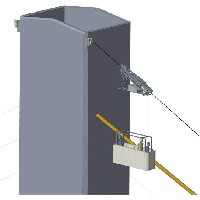Spain’s Ministry of Transport and Sustainable Mobility has approved a major section of the SE-40 ring road near Seville, featuring what will become the country’s longest viaduct. The approval, published in the Official State Gazette (BOE) on 6 November, covers the 5.07km stretch between Dos Hermanas-Palomares and Coria del Río.
The new bridge being built for the Ministry of Transport and Sustainable Mobility will be coordinated by the public engineering company Ineco. Detailed structural design is being carried out by a joint venture of Tylin Spain SL and MC2 Estudio de Ingeniería, while preliminary concept studies were prepared by Ayesa. The estimated budget for the works is US$742 million (€688.11 million).
 Visualisation of the SE-40 cable-stayed bridge over the Guadalquivir River (Ministry of Transport and Sustainable Mobility)
Visualisation of the SE-40 cable-stayed bridge over the Guadalquivir River (Ministry of Transport and Sustainable Mobility)
The centerpiece of the project is a series of viaducts totaling 3.5km, including a cable-stayed bridge that will span the Guadalquivir River without intermediate supports in the water. The main span will measure 366m, and the structure will provide a minimum vertical clearance of 70.8m to allow passage of large vessels. The deck will be 42m wide, accommodating four lanes in each direction, plus cycle and pedestrian paths and landscaped areas of 72,000m².
_600px.jpg)
Official rendering showing the cable-stayed design and panoramic viewpoints (Ministry of Transport and Sustainable Mobility)
The new crossing aims to relieve congestion on the SE-30, which currently serves as the main orbital route for Seville’s metropolitan area. Of the 75km planned for the SE-40, only 38km are currently in service. When complete, the viaduct will surpass the Constitution of 1812 Bridge in Cádiz, which opened in 2015 and measures 3,092m with a clearance of 69m.
The project has been declared urgent under Spanish road legislation. Current activities include geotechnical surveys and dynamic supervision contracts. Construction tenders are expected in 2026, with an estimated opening in 2029, subject to tender and works schedule. Additional works include improvements to the southern roundabout at Coria del Río to enhance traffic flow and safety, addressing long-standing local concerns over congestion during peak hours.




